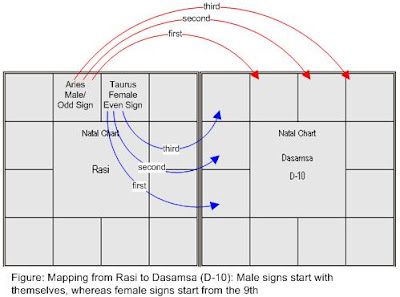Contruction of the Dasamsa/D-10 Chart
As we all know the asterisms/nakshatras that eventually form the Rasis/Signs like Mesha/Aries, Vrishabha/Taurus, etc are laid out around the Earth(360 deg. around us). Since there are 12 signs, each sign is allocated 30 deg. So Mesha/Aries is 30 deg, Vrishabha /Taurusis 30 deg, so on and so forth - very basic. So also we know that every divisional chart is derived from the planetary positions indicated in the Rasi chart.
In order to derive the Dasamsa/D-10 chart Each Rasi/Sign in the main Rasi chart is divided into 10 equal parts of 3 degrees each. So 10 divisions account for the total 30 deg. that every sign is composed of.
As you can see, from the adjacent figure, for male/odd signs, the counting begins from the sign itself. So the first 3 deg of Mesha/Aries, for example, falls in Mesha itself. The second 3 deg. of Mesha falls in Vrishabha/Taurus in the D-10 and so on and so forth. For planets in female/even signs, the counting begins from the 9th house.
Planets in Male signs behave as specific Avatars of Vishnu giving the native the inspiration/life force (as indicated by lagna , the first house) to cross over the river of life - which explains why planets in male signs are determined from the first house. Similarly, planets in Female signs act behave as specific Maha-vidyas giving the native the knowledge (as indicated by the 9th house of Guru) required to cross over the ocean of life - which explains why planets in female signs are determined from the 9th house.
Notice how also there are 10 Avatars of Vishnu (Dasavatar) and the 10 Maha-vidyas (Dasa-mahavidyas) to represent each of the grahas and their placements in either male or female rasis. Another interesting point here is the meaning of Avatar itself. Ava means down or to descend and "tar" means to cross, referring to the diety that descends down to help us cross the ocean of rebirth.
Another interesting point to note is that since there are 10 dasamsas in each sign/rasi, there are a total of 120 dasamsas across the 12 rasis. These 120 dasamsas signifies the 120 years alloted for human life as specified in the vimsottari dasa scheme as well and is indicative of the karma we will engage in throughout our life.
Implications of Graha's/Planet's Position in Rasi and Dasams
As we have noted, for male/odd signs (Mesha/Aries, Mithuna/Gemini, etc) the energy spent is on the self (1st house/lagna). On the other hand, for female/even signs the focus is on dharma/9th house. So obviously the Grahas/Planets placed in Male vs. Female signs have certain implications.
 Planet in Male Sign in Both Rasi and Dasamsa – Since male sings provide energy/inspiration, the use the energy will be to one's own benefit onself– Ex. Sun
Planet in Male Sign in Both Rasi and Dasamsa – Since male sings provide energy/inspiration, the use the energy will be to one's own benefit onself– Ex. Sun Planet in Female Sign in Both Rasi and Dasamsa – Since knowledge is what is given, it will always act Dharmically to everyone’s benefit – Ex. Venus
Planet in Male Sign in Rasi and Female Sign in Dasamsa – Will initially start off being self-focussed but will transform to benefit others – Ex. Moon
Planet in Female Sign in Rasi and Male Sign in Dasamsa – Will initially start off being helpful to others, but then will turn to be more self-focussed – Ex. Jupiter
Planet Placement in Specific Yugas
Depending on what Yuga a planet occupies in the Dasamsa, the impact differs.

Grahas/Planets in Satya Yuga Rasis always produce great results and the native will have full knowledge of the planet.
Grahas/Planets in Treta Yuga Rasis will always require a teacher/mentor/guru for the native to gain knowledge of it
Grahas/Planets in Dwapara Yuga Rasis will always require resources/money for the native to gain knowledge of it
Grahas/Planets in Kali Yuga Rasis will always require tremendous effort if the native has to gain knowledge of it.
Conclusion
It was nice to see the connection between the dasavatars, the dasamahavidyas and the dasamsa chart. There are still some questions about placement in rasi and dasamsa and how that makes the native selfish or dharmic. Additionally, it will be great to see what others think about how this relates to the dasamsa dieties as well.
